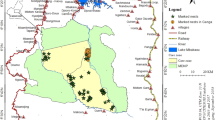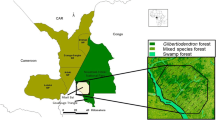Abstract
The Kalinzu Forest Reserve in Uganda comprises various types of vegetation, including mixed mature forest, Parinari-dominated mature and secondary forest, and Musanga-dominated secondary forest. We used a marked-nest census method to examine seasonal changes in chimpanzees' use of the different vegetation types. We made 10 parallel line-transects in the study area; they were 5-km long and 500-m apart. During the first 3–4 walks along the transects, we marked all existing nests. We then conducted 10 main censuses of all transects at 15-day intervals, over a total period of about 5 months. In each main census, we recorded all unmarked nests visible from the transects and marked them. When we saw a nest, we searched for neighboring nests of the same age class ≤30 m of each other, in order to estimate the size and position of nest groups. To improve the accuracy of the estimation of nest density in each census period, we excluded nests that consisted only of brown leaves and corrected the number of nests observed by allowing for the proportion of newly-built nests that would still have green leaves at the next main census. We estimated the population density of chimpanzees in the study area both by the number of individual nests and by the number of nest groups; the two methods gave similar results. We found differences in number of chimpanzees that used different vegetation types in different fruiting seasons, and differences in nest group size related to the different fruiting seasons.
Similar content being viewed by others
REFERENCES
Buckland, S. T. (1985). Perpendicular distance models for line transect sampling. Biometrics 41: 177-195.
Buckland, S. T., Anderson, D.R., Burnham, K. P., and Laake, J. L. (1993). Distance Sampling: Estimating Abundance of Biological Populations, Chapman and Hall, London; Reprinted in 1999 by RUWPA, University of St. Andrews, Scotland.
Burnham, K. P., Anderson, D. R., and Laake, J. L. (1980). Estimation of density from line transect sampling of biological populations. Wildlife Monogr. 72: 1-202.
Chapman, C. A., Wrangham, R.W., and Chapman, L. J. (1995). Ecological constraints on group size: An analysis of spider monkey and chimpanzee subgroups. Behav. Ecol. Sociobiol. 36: 59-70.
Furuichi, T., Hashimoto, C., and Tashiro, Y. (2001). Fruit availability and habitat use by chimpanzees in the Kalinzu Forest, Uganda: Examination of fallback foods. Int. J. Primatol. 21(6): 929-945.
Furuichi, T., Inagaki, H., and Angoue-Ovono, S. (1997). Population density of chimpanzees and gorillas in the Petit Loango Reserve, Gabon: Employing a new method to distinguish between nests of the two species. Int. J. Primatol. 18: 1029-1046.
Ghiglieri, M. P. (1984). The Chimpanzees of Kibale Forest. Columbia University Press, New York.
Hashimoto, C. (1995). Population census of the chimpanzees in the Kalinzu Forest, Uganda: Comparison between methods with nest counts. Primates 36: 477-488.
Hashimoto, C., Furuichi, T., Tashiro, Y., and Kimura, D. (1999). Vegetation of the Kalinzu Forest, Uganda: Ordination of forest types using principal component analysis. African Study Monogr. 20: 229-239.
Howard, P. C. (1991). Nature Conservation in Uganda's Tropical Forest Reserves. IUCN, Gland, Switzerland.
Plumptre, A. J. (2000). Monitoringmammalpopulations with line transect techniques in African forests. J. Applied Ecol 37: 356-368.
Plumptre, A. J., and Reynolds, V. (1996). Censusing chimpanzees in the Budongo Forest, Uganda. Int. J. Primatol. 17: 85-99.
Plumptre, A. J., and Reynolds, V. (1997). Nesting behavior of chimpanzees: Implications for censuses. Int. J. Primatol. 18: 475-485.
Tutin, C. E. G., and Fernandez, M. (1984). Nationwide census of gorilla (Gorilla g. gorilla) and chimpanzee (Pan t. troglodytes) population in Gabon. Am. J. Primatol. 6: 313-336.
Tutin, C. E. G., Ham, R. M., White, L. J. T., Harrison, M. J. S. (1997). The primate community of the Lopé Reserve, Gabon: Diets, responses to fruit scarcity, and effects on biomass. Am. J. Primatol. 42: 1-24.
Tutin, C. E. G., Parnell, R. J., White, L. J. T., and Fernandez, M. (1995). Nest building by lowland gorillas in the Lopé Reserve, Gabon: Environmental influences and implications for censusing. Int. J. Primatol. 16: 53-76.
White, L. J. T. (1994). Biomass of rain forest mammals in the Lopé Reserve, Gabon. J. Anim. Ecol. 63: 499-512.
Whitesides, G. H., Oates, J. F., Green, S. M., and Kluberdanz, R. P. (1988). Estimating primate densities from transects in a west African rain forest:Acomparison of techniques. J. Anim. Ecol. 57: 345-367.
Wrangham, R.W., Chapman, C. A., Clark-Arcadi, A. P., and Isabirye-Basuta, G. (1996). Social ecology of Kanyawara chimpanzees: Implications for understanding the costs of great ape groups. In McGrew, E. W., Marchant, L. F., and Nishida, T. (eds.), Great Ape Societies, Cambridge University Press, Cambridge, pp. 45-57.
Wrangham, R. W., Conklin, N. L., Chapman, C. A., Hunt, K. D. (1991). The significance of fibrous foods for Kibale Forest chimpanzees. Phil. Trans. R. Soc. Lond. B. 334: 171-178.
Author information
Authors and Affiliations
Corresponding author
Rights and permissions
About this article
Cite this article
Furuichi, T., Hashimoto, C. & Tashiro, Y. Extended Application of a Marked-Nest Census Method to Examine Seasonal Changes in Habitat Use by Chimpanzees. International Journal of Primatology 22, 913–928 (2001). https://doi.org/10.1023/A:1012057403512
Issue Date:
DOI: https://doi.org/10.1023/A:1012057403512




